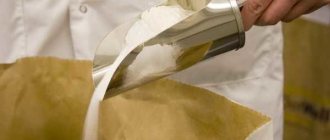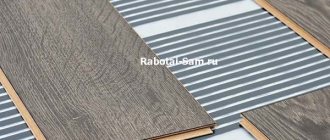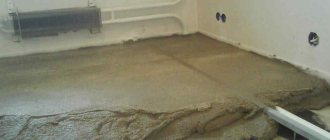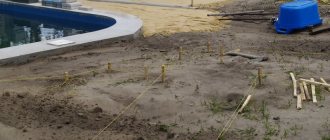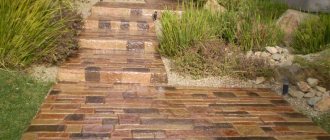Floors made of marble chips are the hallmark of most public spaces in the USSR. Just remember the halls, lobbies in schools and universities, grocery stores and shopping centers. It was not in vain that Soviet craftsmen chose this material. It's not only about the unusual appearance, but also about the wear resistance and unusual strength of the material.
However, the coating was not created in the country of the Soviets, but in sunny Italy, where craftsmen often used mosaics in decoration. This technology of work is called “Venetian floors” or “terrazzo”. The popular decor has been decorating architectural monuments and Italian estates for centuries.
The technique of making floors has migrated into modern design. Gradually, stereotypes were erased, and craftsmen appreciated the unique characteristics of the material. It can be given any shape, any materials can be mixed, and an original coating can be obtained with designs of a wide variety of shapes.
Terrazzo is widely used not only for decorating facades, floors in industrial and public buildings, but is also widely used in the design of floors in kitchens, bathrooms, greenhouses, and attic floors.
Coating manufacturing methods
You can make a floor with stone chips using several techniques:
The first way is to make concrete slabs with your own hands or buy ready-made ones in a store.
This option is often used by those who are going to use the material on the street - laying sidewalks, decorating patios, verandas, parking spaces, and cladding buildings.
Making slabs is a labor-intensive process. To work, the master will need casting molds, as well as properly prepared concrete mortar. Professionals advise using special equipment - a vibrating table. It is needed so that during work, voids do not form in large slabs, which can destroy the entire product.
It is much easier to buy ready-made material. Manufacturers offer different textured materials for any type of finishing. To decorate the floors you can use:
- concrete slabs using crumbs, which are installed on a prepared surface or glued with special glue;
- stone or marble panels;
- slabs are large polished rectangles of stone.
Finished products are much easier to install: you need to buy glue or the right solution.
The second way to make a floor from marble chips is to use a self-leveling floor.
More details about the technology: craftsmen use concrete for their work, obtaining a mixture of a binding mass with the addition of marble or stone chips. The prepared mosaic mortar is covered with a pre-prepared base. Typically this is:
- cement strainer;
- floor slab;
- concrete underlying layer.
The applied mixture is leveled, a pattern is given to the surface, and then sanded.
Please note that the appearance of the finished coating and its characteristics depend on the materials used. For example, for finishing you can use artificial or natural stone chips, and also experiment with the components of the binding solution - use polyester or epoxy resins, polyurethane as a base. Each material has its own specifics and properties.
Advantages of floors made of marble chips
The main advantage of the material in comparison with analogues is that the finished coating is a monolithic slab without seams or joints. Therefore, it is more durable than other materials and practically does not require repairs. however, if necessary, it can be easily restored.
In addition, stone chip floors:
- have unique decorative properties;
- hygienic - mold and mildew do not form on the surface;
- harmless, completely environmentally friendly - suitable for use in residential areas where children and allergy sufferers live;
- resistant to stress, friction, moisture, fire, chemicals;
- do not require special care.
Despite all the versatility of the coating, it also has disadvantages. The mixture of concrete and stone chips will remain cold in any weather. If the subtleties of the technology are observed, the coating can be used together with a heated floor.
Disadvantages also include the weight of the finished material, as well as the difficulty of installation. Let's take a closer look at the technology for creating floors from marble chips.
Technological process
Marble is a natural stone, the destruction of which produces crumbs in the form of crystals of different shapes and sizes. After technical sorting, it is divided into fractions of approximately the same size.
Thanks to the qualities given by nature, marble is famous not only for its durability. The crumbs obtained after its processing are non-flammable, fire-resistant, easily formed into individual tiles and used to create mosaic floors.
This type of coating is durable and beautiful
After adding seals and other components, products are obtained that are successfully used to construct high-quality, durable, reliable floors, decorated with a pattern or design.
Mosaic floors made of marble chips are created from white, gray and colored stones. In turn, the color range of the third group of stones is quite wide and varied.
The marble particles needed to create an interesting and vibrant mosaic are pink and red, green and blue, brown and lilac.
The technology for flooring made from marble chips is quite simple, but requires strict adherence to the sequence of work:
- preparation of the base;
- installation of dividing strips;
- preparing the solution;
- pouring the mixture.
The final stage is thorough sanding of the topcoat, which is performed no earlier than a week after pouring.
Article on the topic: Design and arrangement of a pond at the dacha with your own hands - options and photos
Components of mosaic mortar
To decorate surfaces, three types of solutions are most often used, depending on the binding material. The first one is cement.
The base is Portland cement, grade no lower than M400. The mixture is mixed in the following proportion: 2 parts cement, 1 part crumbs. The crumbs must be cleaned and dried. Water is added until the desired consistency is obtained. The solution should not be plastic, but rigid and inactive.
To give the finishing coat the desired color, you can use white or colored Portland cement, or use coloring pigments, mineral dyes weighing no more than 15% by weight of the cement. You can also clarify the solution using mineral flour with a fraction size of up to 0.5 mm. The recommended coating thickness is from 50 mm, and the filler fraction is from 20 mm.
After laying the floor, the surface is ground, polished, treated with sealants and hardening impregnations. You can apply varnish.
The use of marble crushed stone and marble chips in concrete mosaic floors
Concrete mosaic floors (terrazzo) are a floor surface that was filled with decorative fillers in the form of crushed marble. After hardening, the surface is ground and, if necessary, coated with hardening impregnations. This mosaic coating consists of two layers: screed and concrete-mosaic mixture. The thickness of the front layer is 20-25mm.
Flooring technology.
The mosaic floor is usually poured in small parts, having previously laid out the required pattern with glass or metal strips. The well-mixed mass is placed in the spaces between the plates and leveled, and any pattern can be formed by adding dye to the solution. Sometimes a mosaic floor is made in this way: after pouring the concrete, marble chips are pressed in to create a unique pattern. After drying, which lasts approximately 5-7 days, the surface is sanded mechanically.
Use of fillers in the production of solution.
In order to achieve lighter shades of the floor, marble flour or marble chips of fractions up to 0.5 mm are added to the mixture. The amount of marble flour depends on the brand of cement used and varies from 20% to 40% by weight of cement. For example, for grade 400 cement, up to 20% marble flour is added. Marble fillers also serve as a compactor for the concrete mixture, filling voids, retarding set and preventing shrinkage, which improves surface quality and leads to a reduction in the number of shrinkage cracks.
To reduce the cost of concrete mosaic coating, marble screenings are used instead of marble flour or marble chips. But in this case, the quality of the floor may become worse and affect the strength characteristics, due to the content of foreign investments (garbage, clay particles) in the marble screenings.
Filler for concrete mosaic floors.
It is best to use marble crushed stone (marble chips) of fractions from 2.5 to 20mm as filler for concrete mosaic floors. Better decorativeness can be achieved if the particles of crushed marble are evenly distributed on the surface of the mosaic floor. Compared to hard stones (granite, gravel, gabbro), marble crushed stone wears out evenly along with cement stone during the operation of the floor, but if you use the above hard stones, then during operation, after some time, the floor surface becomes lumpy and spongy.
The size of the marble crushed stone fraction directly affects the decorative effect of the coating; the larger the fraction, the more beautiful the floor pattern is. On the polished surface of the mosaic bol, it is desirable to have 75-85% occupied by marble crushed stone, and the remaining part by cement stone. Concrete mosaic floors with this coating have a beautiful appearance and are resistant to abrasion.
What other types of binders are used?
Polymer-cement
The binding material of the solution is Portland cement with the addition of polymer materials. Masters include additives in different proportions - from 0.2% by weight of cement to 20%. Polymers improve the characteristics of the coating - they make the surface resistant to moisture and frost, impart elasticity, resistance to tension and bending.
The thickness of the coating layer is from 15 mm, and the thickness of the filler is less than 10 mm. The finishing of the coating is simpler than when using cement mortar: polishing or the application of polymer impregnations will be required.
Polymer concrete
Epoxy, polyurethane, polymethyl methacrylate, and ether resins are used as binders. Polymer concrete coating can be made with a thickness of 2 mm, and it has high performance characteristics: the durability of the coating exceeds all other types of concrete floors. The filler size should not exceed 0.2 mm - for example, you can use sand of different colors.
A variety of filler types are used for different solutions: the type of material affects the decorative qualities of the coating, as well as its strength.
Production of terratio floors – technology
Mosaic coatings are made from terraz mosaic mortar, which is made from M400 cement and from stone chips obtained from polished rock materials granite, marble, labradorite, etc. To obtain dark and gray coatings, the most common gray Portland cement is used. Light coatings are obtained by introducing special whitening components into cement in quantities of almost forty percent. For additives, stone flour with a large fraction of grains is used, obtained by breaking white marble. Although this additive reduces the strength of the solution, it is still better to use white Portland cement.
To obtain a colored type of mortar, it is recommended to use colored types of cement produced by industry in brown, yellow, red, green or blue. If this is not possible, to achieve colored solutions, bleached gray or white cement is mixed dry with mineral pigments. They should be added to no more than fifteen percent by weight of the cement. For this, red lead or mumiyo is used to obtain a red composition, ocher is used for yellow, chromium oxide is used to obtain green, ultramarine is used to obtain blue, and manganese peroxide is used to obtain black.
Stone chips are used as filler in terraz composition; their grain size should be below 15 millimeters. A strong solution is obtained by adding crumbs of various sizes to it.
Depending on the grain size, crumbs:
- fine MM – fraction 2.5...5 millimeters;
- average MS - fraction - 5...10 millimeters;
- large MK - fraction - 10...15 millimeters.
Terrace solutions can be prepared using the following ingredients:
- in equal parts colored or gray, white cement grade 400 - one part at a time;
- MM crumbs - one part; MC crumbs - one part, MK crumbs - one part;
- water – 1/2 part.
The amount of water used in this solution will depend on the degree of moisture of the crumbs, so you can increase or decrease this part a little to get a solution that fits well on the surface. Excessive amount of water will sharply deteriorate the quality of the solution.
The type of dye and its quantity depends entirely on the existing color of the chips and the need to obtain a certain saturation of the pattern on the floor. In order to have a floor that produces uniform color shades, it is necessary to prepare a dry mixture of each color in a sufficient volume required for one area. When changing colors, the faucet must be thoroughly cleaned.
Polishing is used to achieve a high quality finish. After fine sanding, the floor surface is polished using M-28 stones, and then polished using felt wheels, adding polishing powder, and then rubbing them with wax paste.
Advantages. The main advantage of such a mosaic floor is its high decorative properties and a high level of wear resistance in comparison with the wear resistance of rock aggregate. Low cost and excellent environmental parameters due to the absence of organic components in it, good hydrophobicity when using special additives.
What fillers are most often used by craftsmen?
- mineral: crumbs remaining after processing minerals - marble, granite, slate, lapis lazuli, dolomite, quartz sand;
- wooden: shavings, cuts of different types of wood;
- ceramic: special mosaic or tile fragments;
- glass.
The size of the aggregate fraction affects the decorative properties. Typically, marble chips come in three sizes:
- large (10-15 mm);
- medium (5-10 mm);
- small (up to 5 mm).
After finishing work is completed, the surface must be filled with crumbs by at least 75%. Craftsmen advise choosing a large fraction - this will give the surface a more attractive appearance. However, it is worth adding crumbs of different sizes to the solution: if you use only coarse filler, cracks will appear in the coating when it dries.
Laying self-leveling floor
Work equipment
The simplest types of coatings, which do not require special tools, consumables or complex work, are ready-made mixtures that imitate mosaic coating. They are easy to mix and apply and do not require extensive finishing such as sanding or polishing. Such coatings include, for example, polymer concrete mortar.
Cement and polymer-cement mixtures have a completely different operating algorithm. Here you will need special equipment for preparation, mixing, laying and finishing the surface.
Sample list of tools:
- rule, level;
- ironer;
- trowel;
- cord;
- chalk;
- manual rammer;
- vibration machine or vibrating screed;
- Grinder;
- abrasive materials: stones for roughing, grinding, polishing.
In addition to these tools, you will need household cleaning items and construction clothing. The list is supplemented depending on the type of coating chosen, the areas being treated and other features.
Stage 1. Preparing the base
The thinner the layer of self-leveling floor, the more requirements are placed on the preparation of the concrete substrate or other base surface. The coating must be cleaned of dirt, dust free, and treated with an electric brush. It is necessary to eliminate defects, repair cracks, chips, and hide communications.
To apply a polymer concrete base, it is necessary that the waviness is no more than 2 mm, and the deviation over the entire surface area is no more than 5-10 mm. It is also recommended to apply a primer suitable for the selected type of coating to the base.
If the base is not suitable for starting work, then you must first apply a regular screed and wait until the solution sets, but does not completely harden.
Stage 2. Installation of separation structures
To create a monochromatic coating, you will need to place construction beacons at a distance of 1-1.5 m from each other.
If we are talking about transferring a design or laying a multi-colored coating, then first mark the ornament on the surface with chalk. Then, temporary wooden slats are installed at the border of the color separation, which are removed after the mosaic solution has partially hardened.
The second way is to install permanent gaskets and separating veins, which can be made from scrap materials - strips of glass, metal, plastic. The recommended thickness of the material is 3-5 cm. They are strengthened on the surface with cement or lightly pressed into a wet base. The upper edge of the vein must be leveled with a mallet to the level of the future floor.
You can lay the coating without using separators, but then you will have to wait until the area adjacent to the applied area sets. The veins create a rigid shape for filling with solution.
In places with large crowds of people, where increased demands are placed on the wear resistance of the floor, it is necessary to further strengthen the structure. This can be done in two ways - add plasticizers to the solution, or perform reinforcement. To do this, you need to install a metal mesh, stepping back from the floor and edges at a distance of a quarter of the thickness of the coating. The structure is fixed with wire.
Stage 3. Laying the coating
The mosaic mixture is applied in accordance with the applied markings. Then it is leveled with a rule and trowels, and then compacted with a special vibrating machine, vibrating screed or manual tamper to the level of the separators, until laitance appears on the surface. The liquid can be removed using a brush or rubber scraper.
Then the separators can be removed, and the resulting seams can be sealed with mortar and the surface leveled. At the junctions of the floor and walls, you can form a plinth using a special template.
The secret to perfect coverage is creating favorable drying conditions. The room temperature must be maintained at least 15 degrees. In order for the solution to harden evenly, the surface must be wetted every two days: this procedure can be carried out using a regular brush or wet sawdust, which must be replaced periodically. The surface is covered with film.
How long the drying process will take depends on the type of solution. On average it is 5-6 days.
Stage 4. Grinding and polishing
You can begin pre-finishing preparation of the coating after the surface has hardened - approximately on the seventh day. You need to carefully choose the moment for grinding. If you start work too early, the crumbs will not be firmly fixed in the solution and will fly out, leaving indentations.
The work is carried out in three stages:
Rip off
The wetted surface, previously sprinkled with sand, is treated with a coarse-grained tool. This cuts off about a third of the outer layer of the hardened mortar to expose the filler.
Sanding with medium or fine grit tools
This is necessary for final leveling of the surface and smoothing out defects. The junction of the floor and the walls is treated with an angle machine, changing the grain size.
Polishing
Additionally, the floor is treated with small M-28 stones and polished with felt discs using polishing mixtures. This is a complex and time-consuming process that can be carried out in several stages.
Mosaic floors: execution technology:
- foundation preparatory work: cleaning, dust removal;
- installation of slats - beacons;
- treatment of bases with adhesive compounds;
- preparation, laying and leveling of the prepared mosaic mixture;
- surface grinding and polishing;
- surface treatment with special protective compounds.
- introduction of decorative aggregates into the surface of freshly laid concrete surfaces.
This technology for making mosaic concrete floors can be used when installing concrete screeds; for the base in this case it is better to use commercial concrete mixtures of a grade no less than M250.
The technological process for laying mosaic concrete is as follows:
- laying ready-mixed concrete according to the prescribed technology;
- it is necessary to apply decorative filler evenly into freshly laid concrete at a rate of approximately fifteen kilograms per square meter;
- the surface is treated using a trowel with replaceable discs;
- we carry out cutting of shrinkage seams;
- when dry, we grind with diamond tools until the surface of the decorative fillers is exposed;
- For shine and protection, the surface is impregnated with a special compound.
Mosaic floors with marble chips
Now let's talk about marble mosaic floors. Such marble chips are a decorative building material, permitted in construction without restrictions, this is due to its environmental friendliness.
Marble chips, or as they are sometimes called, decorative crushed stone, are used in the manufacture of mosaic marble floors. These time-tested technologies never become obsolete and remain as in demand as they were forty years ago. They are simple, reliable, have high wear resistance and other positive consumer characteristics.
Mosaic concrete or terratio is a durable, beautiful material related to hard flooring. A variety of colors and patterns helps to embody all design and color ideas. Terrazio, compared to marble, has a speckled or speckled surface. At the same time, terrazo is an excellent alternative when laying floors, when preference is given to natural stones not only due to the existing appearance, but also has a lower cost. Such floors are less slippery compared to other similar materials.
The use of such finishing material is very diverse, starting with the finishing of corridors, halls, exhibition halls and meeting rooms and a host of other premises. Terrazzo is used almost everywhere where hard flooring is provided. It is recommended to install it if your floor will be constantly exposed to intense operational impacts, for example, at car service centers.
Terrazzo flooring must be laid on solid foundations in blocks, or in a monolithic thin layer of approximately 25 millimeters. In this case, a monolithic floor is sometimes divided using thin slats made of metal, glass or other materials into smaller fragmentary patterns. Then the resulting parts are filled with the prepared terrazzo composition. Enlarged marble chips are sometimes pressed into the top layer using a special roller for this purpose.
When the required pattern is selected and a layer of terrazzo is laid and additional marble chips are pressed in. Then the floor must be leveled and rolled using a manual roller. Afterwards, excess protruding solution residues are removed using brushes and scrapers. After the mixture has completely hardened, begin sanding the floor. It is performed in several stages, starting with coarse grinding and ending with fine grinding. Then the floors are varnished and waxed.
How to care for mosaic floors?
Since concrete is a porous material, it requires a finishing treatment that will protect the surface from the penetration of moisture and dirt. Work must also be carried out if you want to emphasize the texture of the material and give it shine or matte.
The surface is treated with liquid compounds for concrete, which include sealants and hardening impregnations.
Varnishes are often used as sealants. They not only waterproof the surface, but also make it stronger and more durable. The material creates an airtight film on the surface, filling cracks and further leveling the terrazzo. Using varnish, you can achieve a decorative effect on damp or glossy floors.
Strengthening impregnations can be used for both new and old coatings.
Mikhail Stepanov
